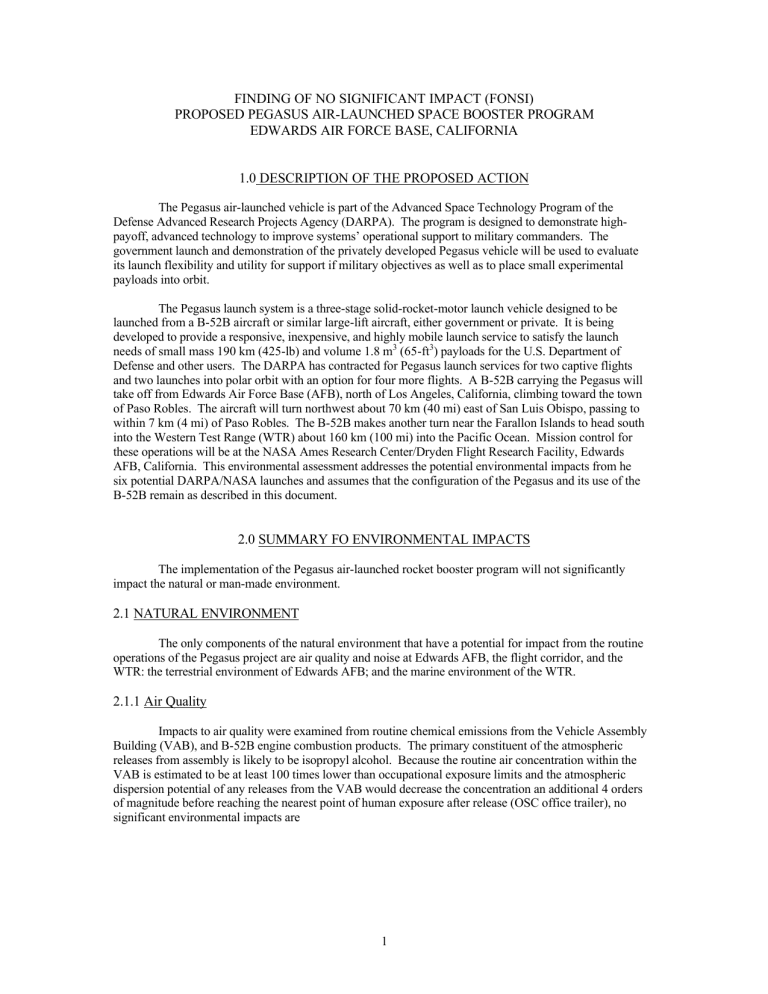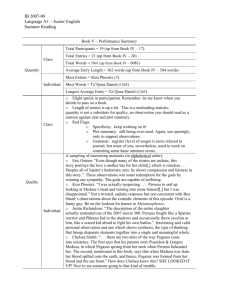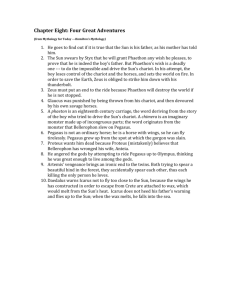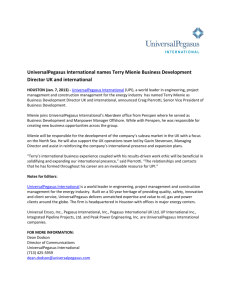FINDING OF NO SIGNIFICANT IMPACT (FONSI) EDWARDS AIR FORCE BASE, CALIFORNIA

FINDING OF NO SIGNIFICANT IMPACT (FONSI)
PROPOSED PEGASUS AIR-LAUNCHED SPACE BOOSTER PROGRAM
EDWARDS AIR FORCE BASE, CALIFORNIA
1.0 DESCRIPTION OF THE PROPOSED ACTION
The Pegasus air-launched vehicle is part of the Advanced Space Technology Program of the
Defense Advanced Research Projects Agency (DARPA). The program is designed to demonstrate highpayoff, advanced technology to improve systems’ operational support to military commanders. The government launch and demonstration of the privately developed Pegasus vehicle will be used to evaluate its launch flexibility and utility for support if military objectives as well as to place small experimental payloads into orbit.
The Pegasus launch system is a three-stage solid-rocket-motor launch vehicle designed to be launched from a B-52B aircraft or similar large-lift aircraft, either government or private. It is being developed to provide a responsive, inexpensive, and highly mobile launch service to satisfy the launch needs of small mass 190 km (425-lb) and volume 1.8 m
3
(65-ft
3
) payloads for the U.S. Department of
Defense and other users. The DARPA has contracted for Pegasus launch services for two captive flights and two launches into polar orbit with an option for four more flights. A B-52B carrying the Pegasus will take off from Edwards Air Force Base (AFB), north of Los Angeles, California, climbing toward the town of Paso Robles. The aircraft will turn northwest about 70 km (40 mi) east of San Luis Obispo, passing to within 7 km (4 mi) of Paso Robles. The B-52B makes another turn near the Farallon Islands to head south into the Western Test Range (WTR) about 160 km (100 mi) into the Pacific Ocean. Mission control for these operations will be at the NASA Ames Research Center/Dryden Flight Research Facility, Edwards
AFB, California. This environmental assessment addresses the potential environmental impacts from he six potential DARPA/NASA launches and assumes that the configuration of the Pegasus and its use of the
B-52B remain as described in this document.
2.0 SUMMARY FO ENVIRONMENTAL IMPACTS
The implementation of the Pegasus air-launched rocket booster program will not significantly impact the natural or man-made environment.
2.1 NATURAL ENVIRONMENT
The only components of the natural environment that have a potential for impact from the routine operations of the Pegasus project are air quality and noise at Edwards AFB, the flight corridor, and the
WTR: the terrestrial environment of Edwards AFB; and the marine environment of the WTR.
2.1.1 Air Quality
Impacts to air quality were examined from routine chemical emissions from the Vehicle Assembly
Building (VAB), and B-52B engine combustion products. The primary constituent of the atmospheric releases from assembly is likely to be isopropyl alcohol. Because the routine air concentration within the
VAB is estimated to be at least 100 times lower than occupational exposure limits and the atmospheric dispersion potential of any releases from the VAB would decrease the concentration an additional 4 orders of magnitude before reaching the nearest point of human exposure after release (OSC office trailer), no significant environmental impacts are
1
expected from the routine assembly of the Pegasus. A chemical spill within the VAB would require shortterm mitigative actions and is not expected to create a health hazard.
Noise and jet engine combustion products from the four B-52B takeoffs is not expected to be significant addition to the flight testing activities currently under way at Edwards AFB. Upon leaving
Edwards AFB, the B-52B will climb to an altitude of about 6,100m (20,000 ft) before crossing the Edwards
AFB boundary proceeding to an altitude of about 12,200 m (40,000 ft) for its flight through the land corridor on its way to the WTR. During this flight from Edwards AFB, the noise and jet engine combustion products will be released at such and altitude as to be of no consequence to humans or the natural environment.
2.1.2 Ecology
Ecological impacts are not expected to occur from the routine chemical emissions from the
Pegasus assembly or from the noise and jet engine combustion products produced by the B-52B as it taxies and takes off from Edwards AFB, travels through the land corridor and launches Pegasus in the WTR.
2.2 MANMADE ENVIRONMENT
Pegasus is also not likely to cause socioeconomic impacts. Because of the transient nature of
Edwards AFB personnel as a result of project initiation and termination, the addition of eight fulltime workers and 12 temporary workers is not expected to have an observable impact on the manmade environment (housing and community services, such as hospitals, schools, traffic congestion, etc.).
3.0 FINDINGS
Based upon the preceding discussion, a finding of no significant impact is made. An
Environmental Assessment of the proposed action dated July 1989, is on file at:
Department of the Air Force
HQ Space Systems Division/DEV
Attn: Captain Hector E. Malave
P.O. Box 92960, World Way Postal Center
Los Angeles, CA 90009-2960
2




